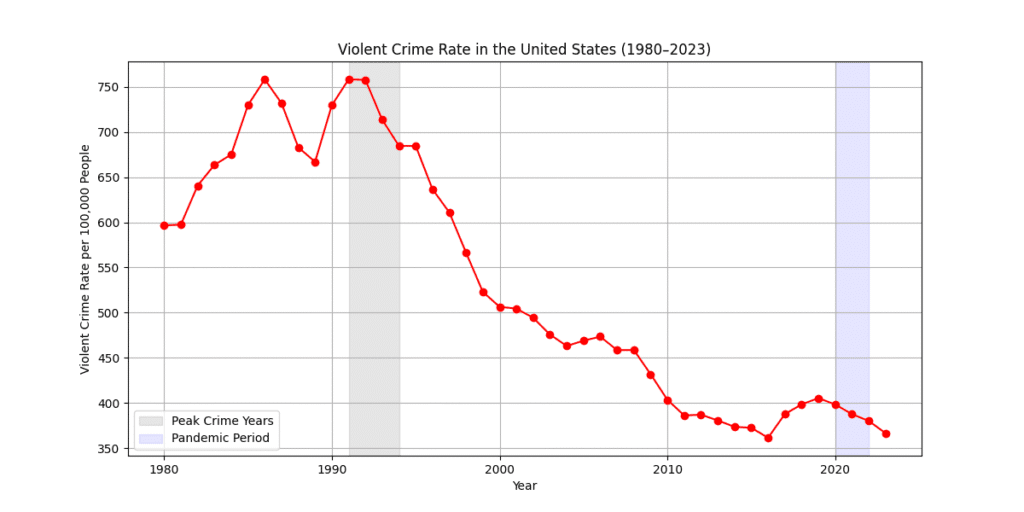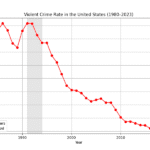Violent Crime: Reports Vs. Reality
While Americans continue to grapple with the effects of crime, mainstream media reports that violent crime rates have been falling across the U.S. in 2025. The DC Crime Crackdown is probably a representative microcosm of the differences between reports and realities.
In response to what he described as a “crime emergency,” President Donald Trump initiated an unprecedented federal takeover of the D.C. Metropolitan Police Department on August 11, 2025. This action, framed as “Liberation Day in D.C.,” was justified by the administration as necessary to combat rising violence, protect federal workers, and restore public order.
The intervention was authorized under Section 740 of the D.C. Home Rule Act, allowing the president to assume control of the police for federal purposes. The takeover places the MPD under the command of Attorney General Pam Bondi, sidelining local leadership including Mayor Muriel Bowser and Police Chief Pamela Smith. The federal control is temporary, lasting 30 days, unless extended by Congress
The executive order also:
- Deployed 800 National Guard troops and 500 federal law enforcement agents from agencies like the FBI, ATF, DEA, ICE, and Secret Service.
- Directed the creation of specialized units and a quick reaction force.
- Ordered investigations into housing safety and transit conditions.
- Called for updates to MPD policies and procedures 3.
While the Trump administration cited high-profile crimes and urban decay as justification, D.C. officials and critics argue the move is politically motivated, pointing to data showing violent crime has dropped to a 30-year low. The intervention has sparked intense debate over federal overreach, local autonomy, and the future of D.C. governance
So what is the truth? Here are some AI-generated statistics suggest:
- Homicides dropped 17% in the first half of 2025 compared to the same period in 2024.
- Gun assaults and carjackings also saw significant declines.
- Major cities reported historic reductions in homicides:
- Baltimore: 22% drop in homicides, 19% drop in non-fatal shootings.
- Chicago: 32% fewer homicides, 39% fewer shootings.
- Los Angeles: 20% drop in homicides, nearing a 60-year low.
These declines are attributed to a mix of factors, including post-pandemic stabilization, community engagement strategies, and possibly the re-incarceration of repeat offenders.
However, on August 11 alone, the U.S. experienced a series of violent incidents:
- A triple homicide in an Austin, Texas Target parking lot.
- A double homicide in a Seattle park.
- A quadruple murder in Montana, prompting a statewide manhunt.
- A shooting at the CDC headquarters.
Timeline of Major Violent Crime Incidents Reported for August 2025 through the 24th.
August 1
- Anaconda, MT: 4 killed in a bar shooting; suspect fled, prompting a manhunt.
- Memphis, TN: 1 killed, 3 injured in a drug deal gone wrong.
- Mayagüez, PR: Teen killed, 5 injured in nightclub shooting during university prep week.
August 2–3
- Harvey, IL: 1 killed, 6 injured during a party shootout.
- Omaha, NE: 7 injured in liquor store shooting.
- Augusta, GA: 1 killed, 3 injured near auto parts store and gas station.
- Virginia Beach, VA: 4 injured in early morning shooting.
August 4–6
- Los Angeles, CA: 2 killed, 6 injured at unauthorized festival after-party.
- Fort Stewart, GA: Army sergeant accused of shooting 5 service members.
August 7–9
- East Cleveland, OH: 2 killed, 2 injured in domestic dispute; suspect shot two officers.
- Baltimore, MD: 1 killed, 5 injured, including a 5-year-old girl.
- Midland, TX: 4 injured in street brawl turned shooting.
August 10–11
- Jackson, MS: 8 injured near nightclub.
- Chicago, IL: Multiple shootings with 1 killed and 14 injured across three incidents.
- Josephine County, OR: 5 killed in family murder-suicide.
August 16–18
- Chicago, IL: 4 injured in Near West Side.
- Indianapolis, IN: 4 injured in Martindale–Brightwood.
- Mount Carbon, WV: 2 killed, 3 injured in carport shooting; shooter died by suicide.
August 22–24
- Perry, FL: 2 teens killed, 2 injured at apartment complex.
- Kansas City, MO: 2 killed, 3 injured in parking lot argument.
- New York City, NY: Multiple shootings including 1 killed, 8 injured at a basketball tournament and nightclub.
That sounds pretty violent to me!
As with almost any politically motivated debate, the truth lies somewhere in between! In early 1990s, violent crime peaked, especially between 1991 and 1994.
- Mid-1990s to 2014: Steady decline due to various factors including policing strategies and economic improvements, and I would add the Right To Carry Movement.
- 2020–2022: Slight uptick during the COVID-19 pandemic, likely influenced by social disruptions and economic stress.
- 2023: Continued decline, aligning with broader national trends.

However, the low numbers reported on the graph, don’t realistically represent the true numbers in violent crime today. Most crime data reported to the FBI comes through the National Incident-Based Reporting System (NIBRS) or the older Uniform Crime Reporting (UCR) Program. These systems are voluntary, meaning agencies can choose whether to participate. Participation and data completeness vary by state and year. If a department doesn’t participate, its data won’t be reflected in national FBI crime statistics.
There are several reasons why some agencies might not report, including:
- Lack of resources or technical capability to submit data
- Agency policy or internal prioritization
- Errors or delays in reporting
- Concerns about public image or funding
- Political considerations
As of 2021, the FBI officially transitioned to NIBRS-only data collection, phasing out the UCR program. However, some large cities have not fully adopted NIBRS, resulting in gaps in reporting. This shift has led to a drop in reported crime numbers—not necessarily because crime has decreased, but because fewer agencies are currently submitting NIBRS data. As a result, national statistics may underrepresent actual crime levels due to incomplete participation.
Mississippi is not immune from the debate. Recently, Governor Newsome of California and our own Governor Tate Reeves exchanged jabs on the topic. While crime is down in the Magnolia State, Jackson still leads the nation in murders per capita by a wide margin. A trend state leaders are hoping to change by bringing in more law enforcement officers through the state funded Capital Police.
Regardless of what your belief is about the “real” crime numbers, a violent crime can still happen to you anywhere at anytime. I encourage everyone to obtain their firearms permit and become more comfortable carrying your firearm as much as possible.

